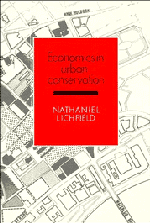Book contents
- Frontmatter
- Contents
- List of diagrams, tables and plans
- Preface
- Acknowledgements
- Introduction
- Part I Planning and management in the conservation of the urban system
- Part II Conservation of the cultural built heritage
- 4 The nature of the cultural built heritage
- 5 Identification and protection of the CBH
- 6 Management and planning in the conservation of the urban cultural heritage
- Part III Economics in urban conservation
- Part IV Selected tools of economic analysis for project evaluation
- Part V Case studies in the economics of conservation of the CBH
- Notes
- Bibliography
- Index
5 - Identification and protection of the CBH
Published online by Cambridge University Press: 10 November 2010
- Frontmatter
- Contents
- List of diagrams, tables and plans
- Preface
- Acknowledgements
- Introduction
- Part I Planning and management in the conservation of the urban system
- Part II Conservation of the cultural built heritage
- 4 The nature of the cultural built heritage
- 5 Identification and protection of the CBH
- 6 Management and planning in the conservation of the urban cultural heritage
- Part III Economics in urban conservation
- Part IV Selected tools of economic analysis for project evaluation
- Part V Case studies in the economics of conservation of the CBH
- Notes
- Bibliography
- Index
Summary
The issue
As indicated above (4.4) a government cannot protect all possible candidates in the CBH and must accordingly identify those objects which it does decide to protect. For this purpose we distinguish between an inventory of possible candidates which can be screened into a list for protection. This calls for a comparative estimation of the cultural value of the various objects, with priority for those of higher value. This estimation is elusive for a number of reasons. Cultural value is an intangible quality which is difficult to measure. There is no exchange value in the market as a guide to contemporary valuation by individuals. There is no way of establishing the values which will be held by future generations, on whose behalf the selection is being made.
Despite the difficulties, it is important to have a robust method of identification, for a variety of reasons. Just because the criteria for selection are intangible and subjective, there is considerable room for debate which can erode the time needed for concentration on the conservation itself. Criteria which are not understandable and acceptable will not secure the necessary resources for conservation. There is need to secure the confidence of those affected by the conservation measures, viz. owners/developers of the properties concerned, or the taxpayers called upon to find the financial resources for conservation. There needs to be some firm basis for an action programme within the overall conservation strategy.
- Type
- Chapter
- Information
- Economics in Urban Conservation , pp. 77 - 90Publisher: Cambridge University PressPrint publication year: 1989



